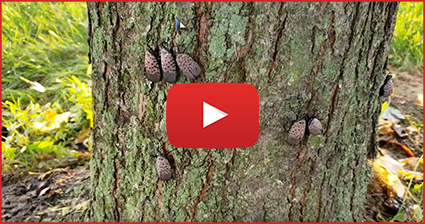Category Archives: Spotted Lanternflies
Exterminators Winning the Race to Eradicate Spotted Lanternflies
June 20, 2022Spotted lanternflies: They are more colorful and attractive than most pests, so why are they so bad?
First, they are an invasive pest that feeds on a large variety of plant species, including those in the agricultural, timber, and ornamental industries, as well as backyard plants.
While they may not actually kill the trees they feed on, they are considered to be a plant stressor and may contribute to long-term weakening of established plants and trees. When combined with other stressors such as other insects, diseases, or weather, they can cause significant damage. They especially settle in grapevines and maple or black walnut saplings or trees.
As for their appearance, they belong to the insect family Fulgoridae, or planthoppers. This group of insects was named after “Fulgora,” the Roman goddess of lightning, because they were thought to be luminescent like lightning bugs. However, they are not!
Battling the spotted lanternfly in South Central Pennsylvania
The lanternfly eggs are laid in the fall of the year (September to November) and hatch in the spring (late April to June). In south central Pennsylvania, the adult flies begin to emerge in July and remain active as adults until they are killed by hard freezes later in the fall. The adult flies are large, about 1 inch in length, have black bodies, and are very mobile. Their forewings are gray with black spots, and the tops are black with gray veins, while their hind wings are red, black, and white.
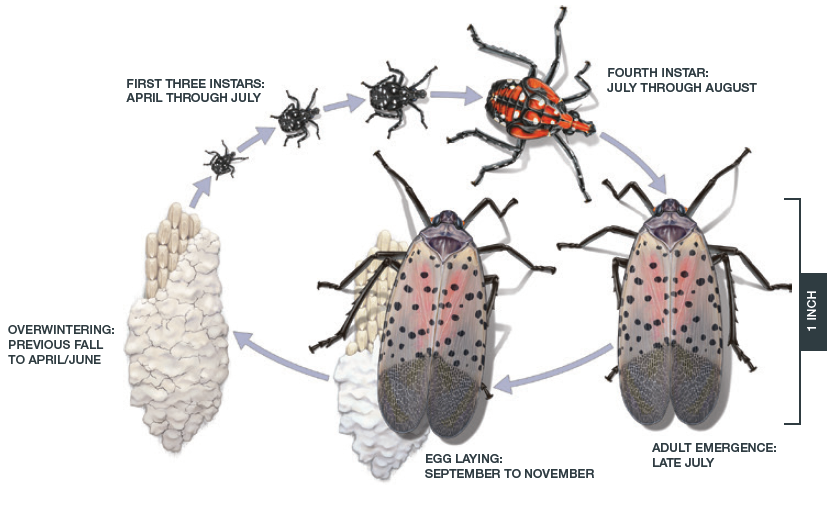
Save Your Trees from Spotted Lanternflies
March 19, 2021If you’re seeing spotted lanternflies in Lancaster County, you’re not alone. These plant-hoppers showed up in Lancaster just a couple of years ago and are seen over the whole county.
Last year, Dominion treated mostly trees in the northern parts, including Lititz, New Holland, Ephrata, and other towns in the spring. But, by late fall, the sapsuckers were targeting trees in every town in Lancaster County, including Manheim, Hempfield, Millersville, Mount Joy, and Willow Street.
Here’s how they ruin trees and what you can do to help prevent them from spreading to other areas and protect your own property.
What are a Spotted Lanternfly’s Natural Enemies?
November 17, 2020By now, you’ve likely learned about the threat that spotted lanternflies post to Pennsylvania’s agriculture industry. The state deemed the spotted lanternfly an invasive species because it feeds through tree bark, excreting a honeydew that’s harmful to trees and plants. The Pennsylvania Department of Agriculture issued an order that calls upon Pennsylvania residents to follow its guidelines to prevent the spread of spotted lanternflies.
At the onset of the infestation, it seemed as though the spotted lanternfly had no known enemies besides humans. We are seeing that play out differently now. Some natural enemies attack the spotted lanternfly and there do exist some natural lanternfly predators. Scientists continue to study possible biological control of the non-native, invasive spotted lanternfly.
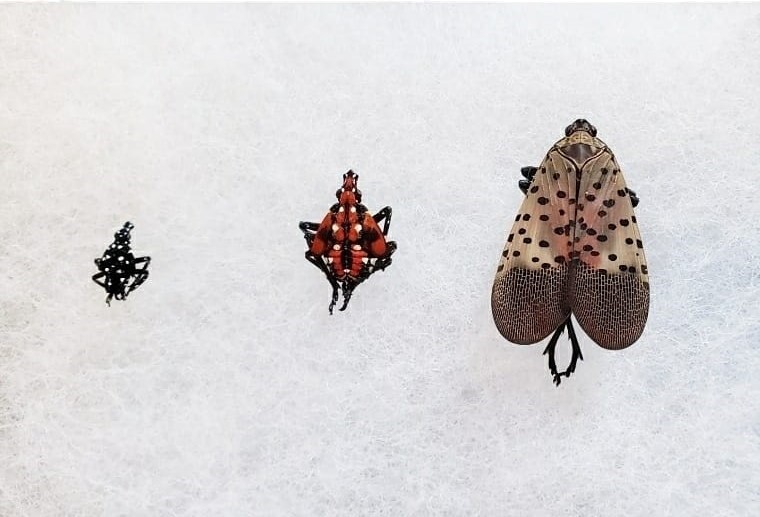
When and How to Kill Spotted Lanternflies: Fall Control is the Answer
October 7, 2020The spotted lanternfly continues to invade Pennsylvania and negatively impact orchards, tree nurseries, forests, vineyards, and properties in general. The spotted lanternfly is a major threat to the state’s wine and beer industry, too.
SLFs feed on tree sap and excrete a tree-suffocating honeydew (partially digested tree sap) that causes damaging mold to form.
The Pennsylvania Agriculture Department recommends treating your property now, for double the impact. Here’s why:
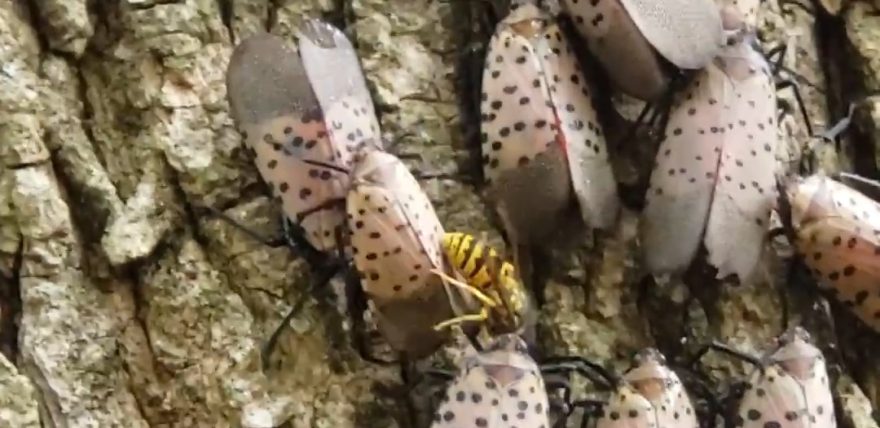
Spotted Lanternflies Help Stinging Insects Thrive
September 2, 2020No doubt about it. Stinging insects are some of the most common pests we’re asked to control. Increasingly, service calls to kill the Spotted Lanternfly are high on the chart too.
This year, we’ve gotten more calls than ever regarding both! There’s an abundance of bald face hornets, yellowjackets, wasps, and European hornets joining the swarms of spotted lanternflies. (European hornets look like Murder hornets, but they are not. The Asian Giant hornet is dubbed the “murder hornet.” Learn more.)
Service calls to control yellowjackets, wasps, and other stinging insects have increased dramatically this year and started earlier. Greg Pettis, Dominion’s president, recently went out into the field to help catch up on stinging insects calls. Scary!
Caution! Birds Getting Stuck on Lanternfly Tree Tape
August 4, 2020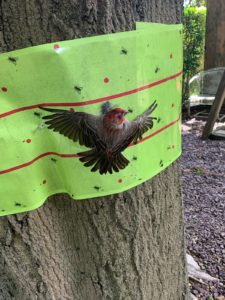
Dominion Pest Control continues its commitment to helping save Pennsylvania agriculture from the invasive, destructive spotted lanternfly. Those familiar with our local pest control company and blog are aware of our efforts to help alert everyone about the devastation these tree-destroying insects wreak on our state, as well as others.
The spotted lanternfly could cost the state’s economy at least $324 million annually, as reported by Penn State Extension on its dedicated spotted lanternfly page.
After Covid-19, The Spotted Lanternfly Could Be Public Enemy No. 1
May 1, 2020There’s never been a better opportunity to play a huge role in supporting Pennsylvania’s farming community. How? Join us in the fight against the spotted lanternfly!
What is a spotted lanternfly?
The spotted lanternfly is a planthopper native to parts of China, India, Vietnam and eastern Asia. An adult lanternfly is about an inch long, with black-spotted gray forewings and hind wings with patches of red and black, and a white band. In the fall, they lay egg masses on their host trees.
It’s an invasive, destructive pest and an economic threat.
Lanternflies: They’re Back! The Impact of Spotted Lanternflies on Pennsylvania
February 12, 2020It’s been a lovely winter away from those pesky Spotted Lanternflies – but they’re on their way back. As we’ve rested comfortably in our warm, cozy homes, the Lanternflies lurked around us, hiding away in egg masses attached to our trees.
One of the questions we’re asked here at Dominion Pest Control is “what can we do?”. It may seem like the little buggers are everywhere and, no matter how many you stomp while out on your afternoon walk, you’ll never get them all.
Spotted Lanternfly comes to Lancaster
July 26, 2019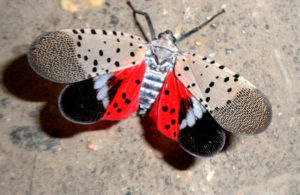 You probably have heard about the Spotted Lanternfly by now, and although beautiful to the eye, these insects are deadly to trees. Starting last year, the SLF was reported to be sighted in Lancaster County, in areas such as Ephrata, Lititz, Denver, and now in the greater areas surrounding Lancaster City. Dominion is no stranger to tackling new pests, in fact we were one of the first companies to go after the infamous ‘Stink Bug’, which wiped out a third of PA’s crops in 2010. We are currently offering treatment to trees and homes for the Spotted Lanternfly, so if you are seeing these creatures, please call our office today to reserve a ‘spot’ in our schedule for a treatment: 717-393-7879.
You probably have heard about the Spotted Lanternfly by now, and although beautiful to the eye, these insects are deadly to trees. Starting last year, the SLF was reported to be sighted in Lancaster County, in areas such as Ephrata, Lititz, Denver, and now in the greater areas surrounding Lancaster City. Dominion is no stranger to tackling new pests, in fact we were one of the first companies to go after the infamous ‘Stink Bug’, which wiped out a third of PA’s crops in 2010. We are currently offering treatment to trees and homes for the Spotted Lanternfly, so if you are seeing these creatures, please call our office today to reserve a ‘spot’ in our schedule for a treatment: 717-393-7879.
Click to see Dominion’s owner show actual Spotted Lanternflies on a tree in Lancaster:
Spotted Lanternflies Have Been Spotted! Here’s What to Do
You may have heard in recent news that the Spotted Lanternfly has landed in Pennsylvania. This is true! An invasive species native to China, Bangladesh, and Vietnam, Spotted Lanternflies have made their way to 14 unsuspecting Pennsylvania counties, including Berks, Lancaster, Philadelphia, Dauphin, Montgomery, Monroe, and Lehigh counties.
We know what you’re thinking: it’s just another bug! Kill it and move on! With these little buggers, not the case. The PA Department of Agriculture has labeled spotted lanternflies as a dangerous invasive species and any sightings should be reported online or via phone at 1-888-4BADFLY.
